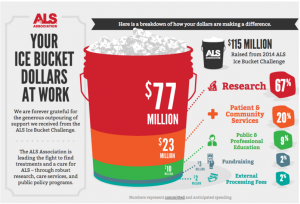By Michelle Engle
Edited by Tamara Vital and Christina Marvin
Remember when everyone was dumping buckets of ice water over their heads “in the name of science”? Did you ever wonder what happened after that?
When the ALS Ice Bucket challenge went viral in the summer of 2014, everyone from elementary school students to celebrities came together to raise $220 million for research into amyotrophic lateral sclerosis, a devastating neurodegenerative disease. In the two years since then, scientists funded by this money have made extremely important scientific breakthroughs in understanding the causes and development of the disease.
In 2015, one year after the Ice Bucket challenge, the Wong lab at Johns Hopkins University published their discovery of the role of the TDP-43 protein that clumps in neurons of patients with ALS. Scientists learned that the TDP-43 protein clumps prevent proper splicing of RNA and therefore block the correct formation of new proteins. The inability to form new proteins prevents the neuron from being able to respond to stimuli correctly and delays neuronal responses. Although these protein clumps had been known as a part of the disease for ten years already, the breakthrough came after the additional funding from the ice bucket challenge allowed more researchers to study the problem. Understanding the disease at the cellular level is important for designing treatments for the disease.
The funding from the ice bucket challenge also allowed American labs to join the international initiative, Project MinE, to find new genetic causes of ALS. This summer, the Landers lab at the University of Massachusetts Medical School, together with the other Project MinE members, discovered NEK1, a new gene involved in both inherited and non-inherited forms of ALS. NEK1 was previously shown to be involved in the cytoskeleton, which holds the cell’s shape and allows neurons to grow new connections. NEK1 is also involved with the mitochondria in neurons, which creates the energy for the cell. A new project creating a mouse model for ALS with this new gene is already underway. The discovery of a new gene involved in ALS may be an important first step to developing new drugs to treat the disease.
The ice bucket challenge, silly as it seemed, generated considerable interest and donation money. When communities come together to engage in science, everyone wins. Supporting scientists allows their research to progress, which eventually benefits society and the community in general. The increased support for scientists in this field has produced important knowledge about ALS, and we are now that much closer to understanding, preventing, and treating the disease, thanks to a few buckets of ice!

